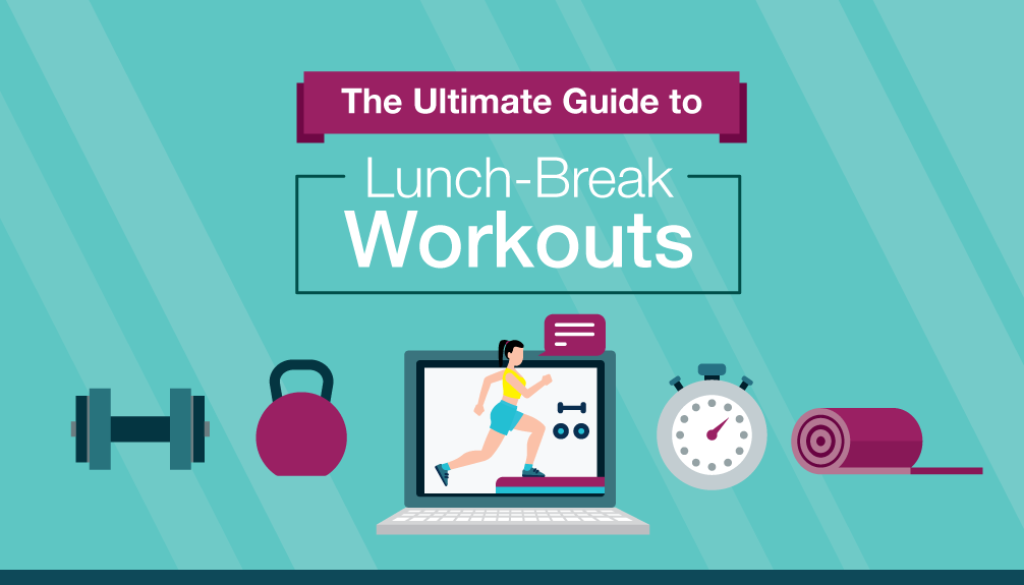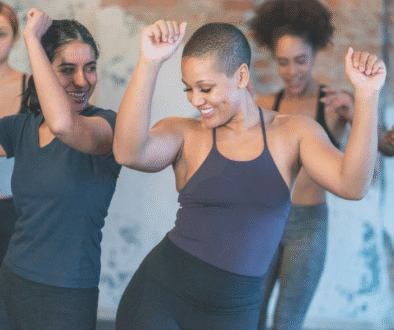Master Your Lunch-Break Workout Without Going to the Gym
By Kristin Seymour
If you’re new to working at home, you may be rethinking your normal fitness routines. With plenty of free online workouts, apps and streaming services, finding an at-home workout that suits your needs should be simple—in theory. The challenge is getting in the habit of doing a workout routine at home when your entire routine has changed. Keep reading for some motivation to get up and get moving.
Why work out at lunch?
Let’s face it, some of us struggle to get up earlier than necessary in the morning or prefer crashing on the couch to crushing a workout once the workday is done. A lunch-break workout routine is the perfect solution. You already take a midday break to eat, right? A lunch prepped ahead of time doesn’t take long to eat which could leave you 20 or 30 minutes to move your body before you sit down to refuel.
Regular exercise has serious, science-backed advantages. Studies suggest a direct link between workouts and cognitive benefits including better mood and energy levels, a clearer mind, faster learning, sharper memory, enhanced creativity, reduced stress, and even reduced junk food cravings. In one oft-cited study conducted in 2008, researchers discovered that exercise during work hours may boost cognitive benefits even more than workouts done at other times—and improve job performance as well. Because of its mental and physical health benefits, regular exercise can also reduce absenteeism, according to a 2019 review of studies.
Regular workouts don’t only benefit you today. They can also help you stay healthier in the future. Ten years after conducting a randomized, eight-month exercise study on sedentary people, researchers checked in with the participants and discovered that the exercisers in the study had gained less weight and continued to have better cardiovascular fitness than their non-exerciser counterparts.
Bottom line? It’s in an employee’s and employer’s best interest to facilitate a lunch-break workout. Here’s how to make it happen.
How to incorporate lunch-break workouts in your workday
A workday sweat session doesn’t have to be complicated, although it’ll be easier if you plan ahead and have some basic fitness gear handy. Here are a few tips to help you make lunch-break workouts happen.
Make your plan—and your lunch—ahead of time
It’s easy to assume you’ll have plenty of time to find a workout, get it done, make a lunch, and eat during your lunch break—but it’s even easier to talk yourself out of it when the time comes.
Plan ahead to reduce the risk of sabotaging yourself when lunch time rolls around. Make your lunch the night before so all you need to do is pull it out of the fridge after your workout. A healthy, delicious one will help you feel nourished and satisfied.
Schedule it like a meeting
Just as you block off time for important meetings on your calendar, mark off time for your workouts so that nothing interferes. Take it a step further by noting the workout or type of exercise you’ll do so there’s no doubt in your mind as to how you’ll spend that time.
After all, when you know you’ve got a big presentation with a client in the afternoon, you spend time getting prepped and pumped up for it, right? If you’ve got an incredible yoga routine scheduled, imagine how you’ll feel all morning knowing it’s on the horizon.
Dress the part
If you work from home, you may have flexibility in your attire. Dress for the workout you plan to do that day. If you need to look more professional for a Zoom meeting in the morning, you may be able to wear leggings or athletic shorts off-camera. And changing at lunch time will be a breeze.
Invest in affordable fitness gear
You don’t need much to get a killer workout, but a yoga mat, exercise bands, jump rope, and a set or two of dumbbells or a kettlebell can open up your workout possibilities. A fitness tracker may provide extra motivation since you’ll have stats to show for your workouts. Plus, many trackers remind you to move in the first place.
Finding the best at-home workout
Skeptical of whether only 20 or 30 minutes will give you a solid workout? Rest assured: As little as 15 minutes can get the job done—the trick is to up the intensity. As a bonus, these shorter, higher-intensity workouts (generally called HIIT, which stands for high intensity interval training) actually give you a calorie burn that lasts well after your workout, something that a steady state, lower-intensity workout does not do as well.
That said, the best at-home workout is the one you’ll actually do. If you despise exercise that leaves you breathless and sweaty, start with something you enjoy (or at least don’t mind) such as yoga or walking. Once activity becomes a habit, higher intensity workouts may sound more appealing.
If you’re game for any workout and don’t know where to start, here are some at-home workouts you can knock out in 30 minutes or less.
Use an app or streaming service
Workout apps and streaming services abound. Whatever your preference, you can find something to suit you. Most apps have a monthly fee, but generally cost far less than a gym membership.
Find a free workout online
Many websites and trainers offer free workouts online in video or written form. Some require minimal equipment such as exercise bands, while many rely solely on body weight.
Find several examples and sources that are perfect for your lunch-break workout here. When you find a source you love, follow them on social media—they may share bonus workouts, offer encouragement, or introduce you to other trainers.
Get outside
A brisk walk or jog is a simple but effective way to raise your heart rate. Plus, after staring at your computer all morning, it’ll feel amazing to feast your eyes on the outdoors.
Hit the stairs
Running up and down a flight of stairs for a set period gets your lungs—and your legs—burning in no time. Bonus: It’s free and requires no special equipment.
Create your own HIIT workout
You don’t need to be a personal trainer to come up with a quick, effective workout. Here are some super simple ideas that you can use to develop a unique workout that’s perfect for you.
Circuit training
Choose 5 to 10 exercises that target different parts of your body (think of the muscles in your upper body, lower body, the front of your body, and the back of your body, for example). Mix up different moves to include pushing movements (such as push-ups) and pulling (such as a row). Make sure you have at least one cardio station. Then, do each station for a set period of time (maybe 30 or 60 seconds) before moving to the next. Depending on the number of moves you select and the length of time you spend at each station, you could go through the full circuit two times or even three or more.
Another option for circuit training: See how many times you get through the circuit in a set period of time. (This is called an AMRAP, or “as many rounds as possible.”) This is a great way to see your progress.
You could also do your circuit training with an EMOM (every minute on the minute) twist, where you have one minute to complete each set of reps—it’s up to you whether you hustle in order to have more rest before you move on or take your time. Any type of exercise can work, but if nothing comes to mind, consider planks, jumping jacks, sit ups, squats, lunges, and calf raises.
Deck of cards
Don’t want to make all the decisions? Try a Deck of Cards workout where you assign an exercise to each suit and do the number of reps on the card. The cards will tell you exactly what to do.
Tabata
Tabata is the ultimate workout if you’re short on time, as one circuit is only four minutes long. Of course, you can do more than one Tabata circuit (just mix up the type of movement you do) or add it to the end of another workout for a real burner.
The idea is to go all out for 20 seconds and rest for 10, completing eight rounds without reducing your effort. It can be done with any type of exercise, as long as you take the intensity to the max. Try it with burpees, squats, high knees, mountain climbers, sprints, and more.
Conclusion
Whatever type of lunch-break workout you opt to do, give yourself credit for making your health a priority. Don’t beat yourself up if you miss a day—but don’t give up, either. By scheduling your workouts, planning what to do each day, and investing in fitness gear, you’ll get into a lunch-break workout groove in no time.
Bio: Kristen Seymour is a freelance writer and editor who has spent the last 15 years covering topics ranging from food and fitness to pets, tech and travel for outlets including USA Today, Women’s Running, Fit Bottomed Girls (where she’s a co-owner), and many more.




